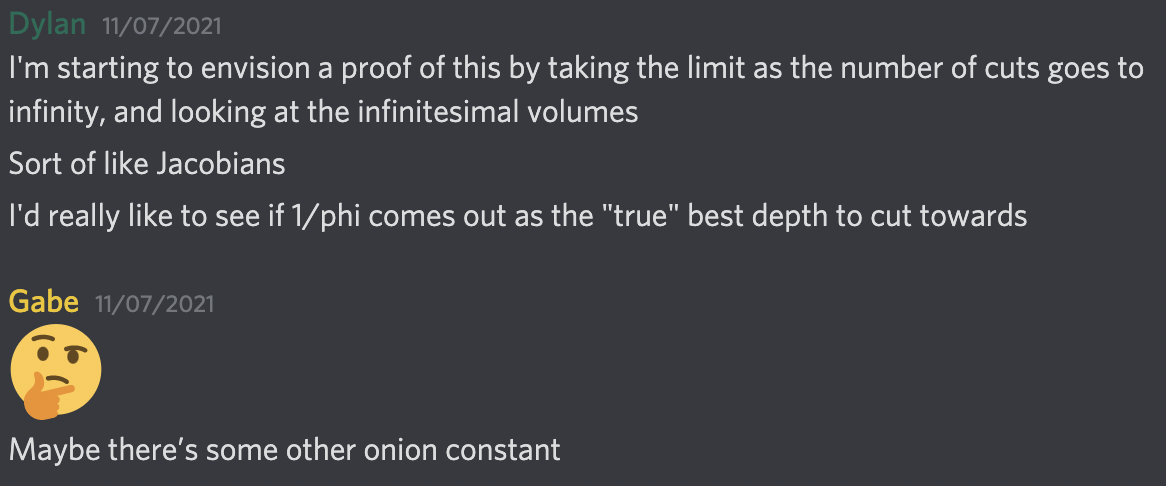Simplifying the Problem
For simplicity, consider a two-dimensional onion.
Simplifying the Problem
Insight: The depth to which you have to aim your knife for radial cuts depends on the number of layers.
Simplifying the Problem
So, we might as well consider the limiting case as the number of layers approaches infinity.
Simplifying the Problem
So, we might as well consider the limiting case as the number of layers approaches infinity.
Simplifying the Problem
Similarly, the number of cuts being made has an effect on the answer. So, for simplicity, we can think of making infinitely many cuts as well.
Live Mathematics


Inspiration: The Jacobian!
Rectangular
Inspiration: The Jacobian!
Problem: With infinitely many layers and cuts, the area of each piece of onion is zero. So, it is hard to measure variance.
Inspiration: The Jacobian!
Solution: Recognize that the Jacobian
Average of a Function
Fact from Integral Calculus: the average value,
Here, over a quarter onion of radius 1, the average "relative area",
Average of a Function
Variance of a Function
To generalize the variance we saw earlier, we recall the variance is the average of the square deviations from the mean! So, the variance of our relative area is
Rest and Reflect
-
All of this is great, but it doesn't answer the question!
-
What allowed all this to work was a coordinate system whose axes cut the onion.
-
Can we find a coordinate system that cuts the onion in the way described by Chef Kenji Lopez-Alt?
New Coordinate System
We make a coordinate system for cutting towards a point a distance
New Coordinate System
This coordinate system only works for the upper half plane, as there are now technically two points in the plane for a given point
Game Plan
In order to mimic our computation for polar coordinates, we need to
- define the region and
- compute the Jacobian.
Define the Region
Fix
Define the Region
Define the Region
So,
Define the Region
Also,
The Jacobian
In order to compute the Jacobian
We need to know what is the relationship between
The Jacobian
Define
Using the law of cosines, we can calculate
The Jacobian
With
The Jacobian
From this, for a given depth
Yikes!
Executing the Plan
Despite how difficult the Jacobian looks, we can proceed as we did before. Putting the pieces our plan together, we need to first compute
Amazingly, this is not as bad as it looks (even though Mathematica cannot do it).
Executing the Plan
Let's look at the numerator
Executing the Plan
Let's look at the numerator
If we go back to the rectangular coordinate system, this would simply be the integral of
Executing the Plan
Now let's look at the denominator
Executing the Plan
Now let's look at the denominator
This is fairly easy to do as well. We can see the denominator is equal to
Executing the Plan
In all, the average ``relative area'' of each piece is
Executing the Plan
Reducing the Problem
So, finding
Reducing the Problem
-
This integral cannot be evaluated by Mathematica. We can be clever, though.
-
We can go back to the Cartesian coordinate system using
Reducing the Problem
But, here we are integrating over a quarter disc. Wouldn't polar coordinates be easier?
Let
So, we now have a closed form for
Rest and Reflect
-
Whew! We have done a lot of integration work with three different coordinate systems. What do we have at the end of it?
-
We have an expression for the variance of the ``relative area'' as a function of the depth
-
Our goal is to minimize variance. What should we do?
-
Take the derivative and set it equal to zero! (then test).
Putting it Together
where
The (2D) Onion Constant
define ס to be the unique root of
Three Dimensions
-
We can also do a similar analysis in three dimensions. We model the onion as nested spheres. We first cut the onion in half, as before.
-
Usually, we cut an onion into slices perpendicular to the root. If we add a
Three Dimensions
-
If we do the same analysis as before, we find the three-dimensional onion constant is approximately 0.484457.
-
This is awfully close to 1/2 (an easy number for humans to estimate. What if we add in the fact that usually we cut off the ends of the onion?
Comprehensive Onion Cutting Guide
- Cut off the ends of the onion, leaving approximately 82.8513% of the length of the onion in the vertical direction.
Comprehensive Onion Cutting Guide
- Cut the onion in half perpendicular to the previous two cuts.
Comprehensive Onion Cutting Guide
- Cut the onion in half perpendicular to the previous two cuts.
Comprehensive Onion Cutting Guide
- Slice the onion parallel to the direction of your initial cuts and perpendicular to the cutting board up the half-onion.
Comprehensive Onion Cutting Guide
- For the final cuts, cut perpendicularly to the previous cuts, but for each cut aim towards a spot 50% of the radius of the onion below the center of the onion.
Comprehensive Onion Cutting Guide
- Profit
Concluding Thoughts
-
Why do this?
-
What now?
-
What questions do you have?